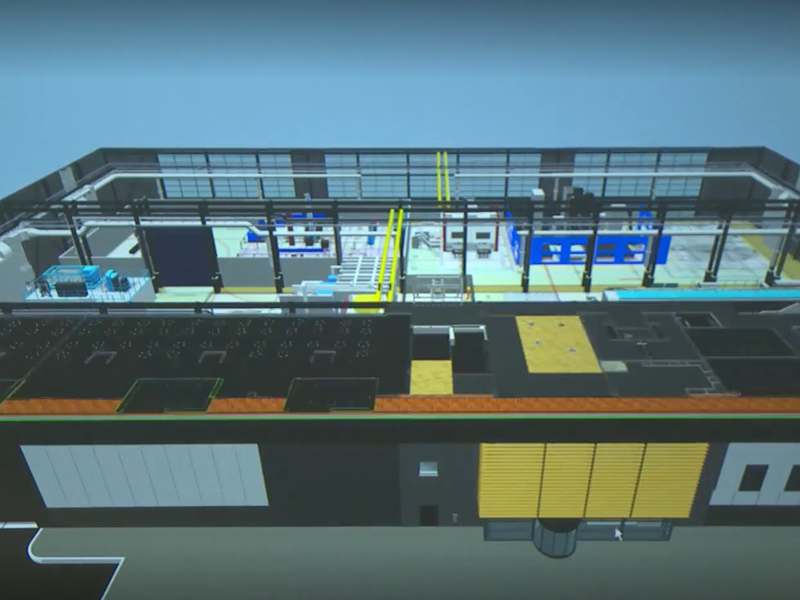Founded in 1904, the British manufacturer Rolls-Royce pioneers cutting-edge technologies from aero-engines to power-generation systems.
Its commitment to innovation means that Rolls-Royce is constantly looking for faster, safer, and more efficient ways of working. So, it’s no surprise that Rolls-Royce has adopted immersive visualisation technology, which it believes has the potential to revolutionise the design and delivery of its products. It deploys this technology in its facilities in the UK as well as in Germany.

“We’re finding that there is a real advantage in terms of cost avoidance and time loss avoidance. We’re getting to an optimal solution without being in the physical world which is a very expensive place to be when you find a mistake. We believe that the use of advanced visualisation techniques, including VR, have the potential to revolutionise the way we engineer and deliver our products, as well as our operations and services.”
Tim Williams-Wood, Global Chief of Manufacturing Systems
In one instance, Rolls-Royce was designing a powerful aerospace gearbox for a new jet engine. It’s a very compact design where components need to be assembled in the right order, otherwise there is a risk that a final piece can’t be added because it needs to be right inside the final product. The virtual environment allows engineers to ensure there’s enough space and clearance for all the parts to fit together in the right order, with warnings appearing if there is a potential clash. These virtual prototypes have saved Rolls-Royce valuable time in building and rebuilding physical prototypes.
Using immersive visualisation has helped Rolls-Royce to design the flow of its manufacturing processes in factories, ensuring that all machines are in the right position and jobs get passed efficiently from machine to machine. Getting the logistics right virtually means employees know the best layout for the real world. The technology has also helped the manufacturer to analyse tooling, headcounts, and resource loads in its facilities, then change things around in seconds virtually to find the best solution. Virtual reality was used in the layout of the assembly line for the Trent XWB, a jet engine used by Airbus, and for the gearbox assembly processes in Dahlewitz, Germany.
Bringing expertise from different teams is a key principle in the way Rolls-Royce uses immersive visualisation solutions. The virtual world translates flat 2D CAD data into fully-realised immersive models that anyone can understand and so provide their input on. Employees from fan blades, installation and controls, casings designs, can all look at the overall design together and highlight issues earlier in the process.
“We were very careful to document our savings and the £1.89 million that we avoided spending in design and lay-out accrued from just 30 issues identified. This doesn’t encapsulate the extra benefits we generated from time reduction or the negation of risk. There are intangible benefits too, as the virtual world is where senior managers and apprentices can meet on equal terms. The improved communication has streamlined product flow around our factory, helped us manage resources and mitigated manufacturing bottlenecks.”
Pre-production Delivery Manager, Rolls-Royce
Rolls-Royce has deployed all-in-one solutions from Virtalis at sites in the UK and Germany, giving its teams multiple ways of interacting with the industry-leading Visionary Render platform.

We installed an ActiveWall in the UK that draws on active stereo technology and features a custom screen and powerful projectors. Movements within the ActiveWall environment are tracked using an integrated tracking system. The user can navigate through the virtual world, pick and manipulate component parts in real-time and make decisions on the fly. Around 20 people can use the ActiveWall at once, enabling cross-disciplinary team co-ordination. People from different functions can, for example, assess how a product can be handled within a virtual cell before a single penny is spent in the real world.
Meanwhile, just outside Berlin, we delivered a bespoke 8.5-metre wide ActiveCube, designed as a more open configuration to make the best use of the space available and enhance communication between all VR-session attendees. The team in Germany also uses HMD-based systems alongside the room-scale VR system, so that engineers can access the virtual model in whatever way is best suited to the task at hand.
All the systems used by Rolls-Royce run the Visionary Render platform that delivers advanced rendering of huge models in real-time with ease of importing from a range of data sources, maintaining naming hierarchies and the all-important metadata. Though a typical aero engine contains approximately 20,000 components, Visionary Render allows for smooth and fluent rendering of even the largest CAD models.
“Our engineers come up with more ideas than they would in 2D because they clearly see the obstacles they face and what needs to be done to overcome them. As a result, we are integrating Visionary Render into our business processes, including product familiarisation, factory planning and the creation of assembly sequence instructions for fitters.”
Prof. Dr Marius Swoboda, Head of Physical, Computational and Design Sciences at Rolls-Royce in Germany